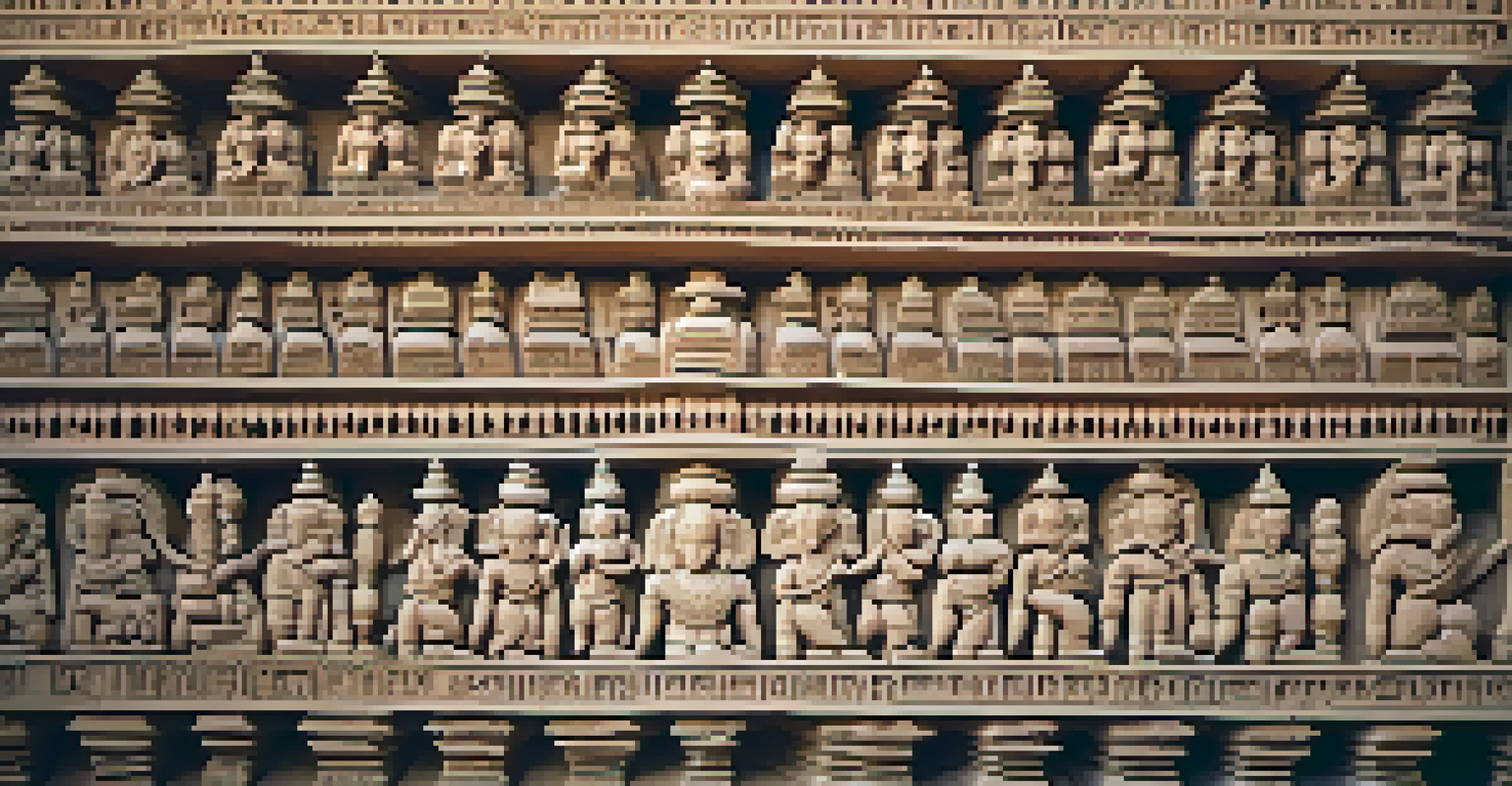The Importance of Heritage Sites in India's Cultural Identity

Heritage Sites as Cultural Symbols of India
Heritage sites in India serve as tangible symbols of the country’s rich history and diverse cultures. Each monument, from the grand Taj Mahal to the intricate carvings of Khajuraho, tells a unique story that contributes to India's collective identity. These sites not only showcase architectural brilliance but also embody the traditions, beliefs, and artistic expressions of the people who built them.
Preservation of heritage is not just about saving the past, but also about creating a better future.
By visiting these heritage sites, both locals and tourists can experience the essence of India's past and how it shapes the present. For instance, the ancient ruins of Hampi reveal insights into the grandeur of the Vijayanagara Empire, while the forts of Rajasthan reflect the valor of Rajput warriors. Thus, these sites act as open history books, inviting exploration and learning.
Furthermore, the preservation of these heritage sites is crucial for maintaining the cultural fabric of the nation. They foster a sense of pride and belonging among Indians, reinforcing the idea that their history is not just a series of events but a living, breathing entity that continues to influence their identity.
Economic Impact of Heritage Sites on Local Communities
Heritage sites also play a significant role in boosting local economies through tourism. Millions of visitors flock to these sites each year, generating income for local businesses, artisans, and guides. For example, the bustling markets around the Jaipur City Palace thrive on the influx of tourists eager to purchase local handicrafts and souvenirs.

This economic activity creates jobs and fosters entrepreneurship, allowing communities to thrive while preserving their cultural heritage. Additionally, the revenue generated from tourism can be reinvested into the maintenance and restoration of these sites, ensuring they remain accessible for future generations.
Heritage Sites as Cultural Symbols
Heritage sites in India reflect the country's rich history and diverse cultures, serving as living reminders of its collective identity.
Moreover, the economic benefits of heritage tourism extend beyond immediate financial gains. They contribute to the overall development of infrastructure in these areas, such as better roads, transportation, and hospitality services, enhancing the quality of life for residents.
Cultural Exchange and Global Understanding
Heritage sites act as bridges for cultural exchange, where people from different backgrounds come together to appreciate India’s rich heritage. These interactions foster understanding and respect among diverse cultures, allowing visitors to gain insights into India's history, traditions, and values. For instance, the vibrant festivals celebrated around these sites often attract international attention, enriching the cultural dialogue.
Heritage is our legacy from the past, what we live with today, and what we pass on to future generations.
When tourists engage with local communities during their visits, they learn about traditional practices such as dance, music, and cuisine, which further deepens their appreciation for India's cultural diversity. This exchange not only benefits visitors but also empowers local communities to share their stories and heritage with the world.
In a globalized world, such cultural exchanges are vital for promoting peace and harmony. By understanding and valuing each other's histories and traditions, we can break down barriers and build a more inclusive society.
Educational Opportunities through Heritage Sites
Heritage sites serve as invaluable educational resources, offering lessons in history, art, and architecture. Schools and universities often organize field trips to these sites, providing students with firsthand experiences that textbooks alone cannot offer. This experiential learning fosters a deeper connection to the subject matter, making it more engaging and memorable.
For example, studying the architectural techniques used in the construction of ancient temples can inspire students to think critically about design and engineering. Similarly, the stories behind these monuments can spark discussions about cultural values, societal changes, and historical events, enriching the educational curriculum.
Economic Benefits of Heritage Tourism
Tourism at heritage sites significantly boosts local economies, creating jobs and fostering entrepreneurship while preserving cultural heritage.
Moreover, many heritage sites offer workshops and guided tours led by knowledgeable locals, enhancing the learning experience. These initiatives not only educate visitors but also empower local communities by providing a platform for sharing their expertise and cultural narratives.
Challenges in Preserving India's Heritage Sites
Despite their significance, many heritage sites in India face challenges that threaten their preservation. Factors such as urbanization, pollution, and climate change pose serious risks to these historical treasures. For instance, the impact of rising pollution levels on the Taj Mahal has been a cause for concern, leading to initiatives aimed at reducing environmental damage.
Additionally, inadequate funding for maintenance and restoration efforts can hinder the preservation of these sites. Many local authorities struggle to allocate sufficient resources, leading to deterioration that could ultimately result in the loss of invaluable cultural heritage.
Raising awareness about the importance of these sites and advocating for their protection is crucial. Engaging communities, government bodies, and NGOs can foster collaborative efforts to ensure that these historical landmarks remain intact for future generations to appreciate.
The Role of Technology in Heritage Site Preservation
In recent years, technology has emerged as a powerful ally in the preservation of heritage sites. Innovative techniques such as 3D scanning and digital mapping are being employed to create detailed records of monuments, allowing for accurate restoration efforts. This technology not only helps in preserving the physical structures but also in creating virtual experiences that can be shared globally.
Virtual reality and augmented reality applications provide immersive experiences, allowing users to explore heritage sites from the comfort of their homes. This accessibility can spark interest in these sites, encouraging more people to visit and support their preservation.
Challenges in Heritage Preservation
Many heritage sites face threats from urbanization, pollution, and inadequate funding, making preservation efforts crucial for future generations.
Moreover, social media platforms play a vital role in raising awareness about heritage conservation. By sharing stories, images, and experiences related to these sites, individuals can inspire others to appreciate and protect their cultural heritage.
The Future of Heritage Sites in India
The future of heritage sites in India hinges on a collective effort to balance preservation with modernization. As cities expand and populations grow, it’s essential to integrate heritage conservation into urban planning and development. This approach ensures that as we build for the future, we do not lose sight of our past.
Engaging younger generations in heritage conservation efforts is also critical. Educational programs that highlight the importance of preserving cultural identity can inspire a sense of responsibility and pride among youth, encouraging them to take active roles in safeguarding their heritage.

Ultimately, the preservation of heritage sites is not just about maintaining structures; it’s about preserving the stories, traditions, and identities that shape our society. By valuing and protecting these sites, we can ensure that they continue to inspire and educate for generations to come.